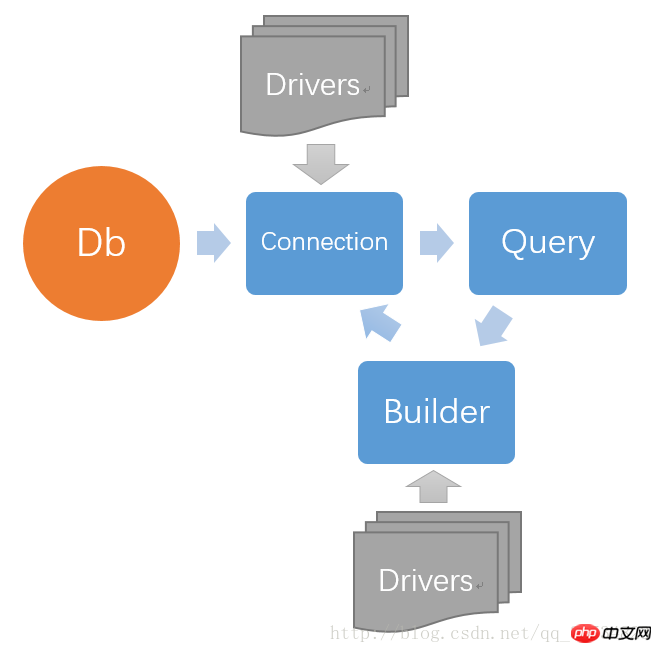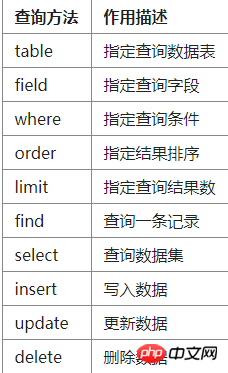About database and model usage of ThinkPHP5
1, TP5 database architecture

1 |
|
1 |
|
1 |
|
1 |
|
2, Database access
In TP5, there are three methods for database access:
Native sql statement.
1 2 |
|
Query constructor

It should be noted that the above In the query method, find, select, insert, update, and delete are all query operations, and the others are auxiliary operations. The auxiliary operations return an object and support chain calls. But once the query operation is executed, it cannot be called further.
The order of different auxiliary operations has no effect, but the order of the same auxiliary operations will.
1 |
|
1 2 3 4 5 6 7 8 9 10 11 12 13 14 15 |
|
Model
ORM Object Relation Mapping Object relational mapping
is mapped to our database through the model table, and then operate the database by operating the model.
We compare it with the query constructor
1 |
|
If it is a model operation, it can be implemented corresponding to the following code
1 2 |
|
This is outside the model, and also It is the value acquisition and setting operations in the controller, but inside the model, the following method is used:
1 2 3 |
|
CURD operation of the model
Creation
Db usage:
1 |
|
Model usage:
1 |
|
Summary:
save (dynamic) Returns: Number of affected records
create(static) Returns: model object instance (method can be called directly)
Read
Db:
1 |
|
Model:
1 |
|
It should be noted that find and select are methods of the query constructor, and get and all are methods of the model. But the model is based on the query constructor, so the model can call the find and select methods, but the query constructor cannot call the get and all methods
Summary:
Method Function Return value
get Query a single record Model object instance
find Query a single record Model object instance
all Query multiple records based on the primary key Array or data set containing model object instances
select Query multiple records based on conditions Containing model object instances Array or data set
Update
Db:
1 |
|
Model:
1 2 3 4 5 6 |
|
Summary:
Method Function Return value
save Update data Number of records affected
update Update data (static) Return model object instance
1 |
|
Delete
Db:
1 |
|
Model:
1 2 3 |
|
Summary:
Method Function Return value
delete Delete current data Number of records affected
destroy Delete specified data (static) Affected Number of records
Now that we have mastered the basic CURD operations of the model, let’s summarize the method differences:
Usage Db class model (dynamic) Model (static)
Create insert save create
Update update save update
Read a single find find get
Read multiple select select all
Delete delete delete destroy destroy
This article explains the database and model usage of ThinkPHP5, For more related content, please pay attention to php Chinese website.
Related recommendations:
A case study on thinkphp5.0 database operation
List some similarities and differences between ThinkPHP5 and ThinkPHP3
Create the simplest ThinkPhp project
The above is the detailed content of About database and model usage of ThinkPHP5. For more information, please follow other related articles on the PHP Chinese website!

Hot AI Tools

Undresser.AI Undress
AI-powered app for creating realistic nude photos

AI Clothes Remover
Online AI tool for removing clothes from photos.

Undress AI Tool
Undress images for free

Clothoff.io
AI clothes remover

Video Face Swap
Swap faces in any video effortlessly with our completely free AI face swap tool!

Hot Article

Hot Tools

Notepad++7.3.1
Easy-to-use and free code editor

SublimeText3 Chinese version
Chinese version, very easy to use

Zend Studio 13.0.1
Powerful PHP integrated development environment

Dreamweaver CS6
Visual web development tools

SublimeText3 Mac version
God-level code editing software (SublimeText3)

Hot Topics
 1655
1655
 14
14
 1413
1413
 52
52
 1306
1306
 25
25
 1252
1252
 29
29
 1226
1226
 24
24
 How to run thinkphp project
Apr 09, 2024 pm 05:33 PM
How to run thinkphp project
Apr 09, 2024 pm 05:33 PM
To run the ThinkPHP project, you need to: install Composer; use Composer to create the project; enter the project directory and execute php bin/console serve; visit http://localhost:8000 to view the welcome page.
 There are several versions of thinkphp
Apr 09, 2024 pm 06:09 PM
There are several versions of thinkphp
Apr 09, 2024 pm 06:09 PM
ThinkPHP has multiple versions designed for different PHP versions. Major versions include 3.2, 5.0, 5.1, and 6.0, while minor versions are used to fix bugs and provide new features. The latest stable version is ThinkPHP 6.0.16. When choosing a version, consider the PHP version, feature requirements, and community support. It is recommended to use the latest stable version for best performance and support.
 How to run thinkphp
Apr 09, 2024 pm 05:39 PM
How to run thinkphp
Apr 09, 2024 pm 05:39 PM
Steps to run ThinkPHP Framework locally: Download and unzip ThinkPHP Framework to a local directory. Create a virtual host (optional) pointing to the ThinkPHP root directory. Configure database connection parameters. Start the web server. Initialize the ThinkPHP application. Access the ThinkPHP application URL and run it.
 Which one is better, laravel or thinkphp?
Apr 09, 2024 pm 03:18 PM
Which one is better, laravel or thinkphp?
Apr 09, 2024 pm 03:18 PM
Performance comparison of Laravel and ThinkPHP frameworks: ThinkPHP generally performs better than Laravel, focusing on optimization and caching. Laravel performs well, but for complex applications, ThinkPHP may be a better fit.
 Development suggestions: How to use the ThinkPHP framework to implement asynchronous tasks
Nov 22, 2023 pm 12:01 PM
Development suggestions: How to use the ThinkPHP framework to implement asynchronous tasks
Nov 22, 2023 pm 12:01 PM
"Development Suggestions: How to Use the ThinkPHP Framework to Implement Asynchronous Tasks" With the rapid development of Internet technology, Web applications have increasingly higher requirements for handling a large number of concurrent requests and complex business logic. In order to improve system performance and user experience, developers often consider using asynchronous tasks to perform some time-consuming operations, such as sending emails, processing file uploads, generating reports, etc. In the field of PHP, the ThinkPHP framework, as a popular development framework, provides some convenient ways to implement asynchronous tasks.
 How to install thinkphp
Apr 09, 2024 pm 05:42 PM
How to install thinkphp
Apr 09, 2024 pm 05:42 PM
ThinkPHP installation steps: Prepare PHP, Composer, and MySQL environments. Create projects using Composer. Install the ThinkPHP framework and dependencies. Configure database connection. Generate application code. Launch the application and visit http://localhost:8000.
 How is the performance of thinkphp?
Apr 09, 2024 pm 05:24 PM
How is the performance of thinkphp?
Apr 09, 2024 pm 05:24 PM
ThinkPHP is a high-performance PHP framework with advantages such as caching mechanism, code optimization, parallel processing and database optimization. Official performance tests show that it can handle more than 10,000 requests per second and is widely used in large-scale websites and enterprise systems such as JD.com and Ctrip in actual applications.
 Development suggestions: How to use the ThinkPHP framework for API development
Nov 22, 2023 pm 05:18 PM
Development suggestions: How to use the ThinkPHP framework for API development
Nov 22, 2023 pm 05:18 PM
Development suggestions: How to use the ThinkPHP framework for API development. With the continuous development of the Internet, the importance of API (Application Programming Interface) has become increasingly prominent. API is a bridge for communication between different applications. It can realize data sharing, function calling and other operations, and provides developers with a relatively simple and fast development method. As an excellent PHP development framework, the ThinkPHP framework is efficient, scalable and easy to use.




